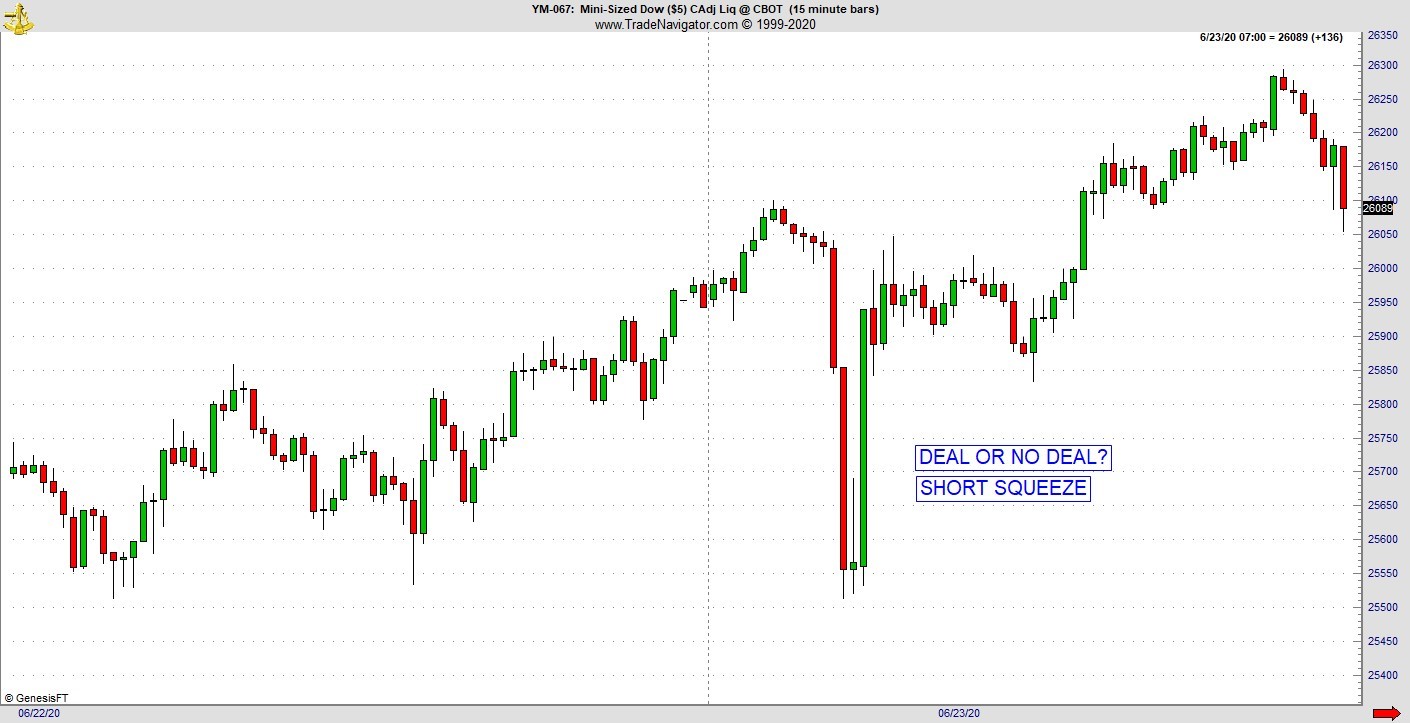Jeff Greenblatt analyzes a recent overnight break-in stock and the what it had to do with phantom US-China trade deal
How many of you were paying attention to the early evening session of the futures market on Monday night? I was and suddenly a crash leg developed on a one-minute chart. Crash is a relative term but when the Dow Jones E-mini futures drops around 500 points in roughly 30 minutes there is usually an important news story attached. If it was the end of it, that would be one thing. In this case, there is the rest of the story.
As it turned out, President Trump’s trade advisor Peter Navarro said the China trade deal was over. The market didn’t like it one bit. Next thing we know the Dow futures and other stock indexes recovered. It regained 408 points on one 15-minute bar (see chart below).

Apparently, Mr. Navarro walked back his comments. When he realized he said those things, he said it wasn’t what he meant but the deal was not done. People have their problems with President Trump but as far as my work here is concerned, I work at keeping my criticisms as it relates to the market. This time I can’t hold back. We’ve never had a President who was so consumed with market activity like this one. Every President in our lifetime has steered clear from jawboning the market on a regular basis. I’ve told you for as long as I’ve been doing this column if Trump was going to live by the rally in his name, he’d eventually take the blame when the market inevitably dropped. With everything going on in this country right now, I’d be incredibly surprised if he gets a second term. One can chalk up Monday evening’s performance to incompetence or something else.
I think there was something deeper going on this time. It would be wishful thinking to believe Mr. Navarro was being honest because let's face it, phase one with China was never a deal. There was no deal, there is no deal and there never will be a deal. It’s surprising to see the market keep falling for this nonsense. For all practical purposes, it was a promise to get serious with the negotiations so both sides could save face.
I believe they tried to manipulate a short squeeze. If the implications weren’t so serious, it would be a joke, but it turned out to be a bad one. Shorts took positions and just as they settled back in their seats with the popcorn to watch the carnage, they became the meal. Panic buying ensued and it became a classic short squeeze. That’s one way to prop up the market. But it didn’t work for long. Imagine you just got here from Mars, your first encounter with American culture is the news cycle and you hear there is no deal, then there is a deal. It’s incredibly pathetic. I think traders and investors are tired of this constant manipulation.
On the second chart, we see some follow-through to the intraday Dow setup shown here last week (see below). Kairos offers one of the most precise ways to sell a rally or buy the dip. This one is not perfect but it’s lower a week down the road.

Today I want to go beyond the numbers. As you know from my Master Class, I teach a complete methodology of price and time vibration work. I taught a complete process of learning how to recognize a Kairos price and time moment.
The early phases of the learning curve make trading more robotic. You must develop enough confidence to know when to pull the trigger at the right time.
When the market moves lightning quick like it did in the February/March sell-off and a couple of weeks ago, you'll be happy to snap up some quick profits because you don't want the snapback coming against you. If you can figure out your edge and take money out of the market on one of those days the Dow moves 1000-2000 points, you are doing well. The qualifier is you only took the trade based on knowing your edge and not just jumping in based on a feeling or a hunch.
So, let's talk about a normal market. Let's say you take a position and it only consolidates. Even on a one-minute chart, if you take a short position and it consolidates for 10 to 15 minutes, that feels like forever. Some of you know what I'm talking about. If you trade a five-minute chart and it doesn't move for 10 bars (50 minutes) that also feels like its forever.
So, let's discuss two factors. Number one, if you take a trade because it starts to break out and you feel the train is leaving the station without you, chances are you are going to get stopped out. You don’t want to take trades in situations where you feel like it's going without you. It’s an emotional trap. How has it worked out for you?
What you want to do is run to the risk which feels scary as opposed to away from it. The best trades are going to come when you are feeling that risk. Of course, this is assuming you've done your homework and understand what your edge is. If you haven't done that, you shouldn't trade, period. There will be some anxiety with taking a trade in a psychologically uncomfortable place but instead of avoiding it, if you embrace it, that is going to be the psychological point where you start going to the next level with your trading. So, think about what you trade and you'll see for yourself.
I learned this lesson over 30 years ago. Briefly, in grad school, I had to take advanced statistics. In my early formative college undergrad years, I barely passed with a C- and the only reason I passed is they graded on a curve.
But my statistics professor in grad school taught me a life lesson. He taught me exactly what to do to solve those wonderful word problems. See, when you work on those problems, there comes a point where it's a fork in the road. You can either do what feels comfortable and you'll end up with the wrong answer or you can listen to the professor and you'll end up in an uncomfortable place, but when you exercise faith and trust what the professor is teaching you to come up with the right answer. you'll need a leap of faith to go into the void and trust it will work out.
In that place, I discovered the right answers! As my neuropaths grew, I quickly realized at first the correct path is uncomfortable, and if I checked myself. If I found I was going down the path of comfort, I stopped.
Turns out this C- student ended up getting the highest grade on the final exam in a class with 80 students. I'm telling you this because trading is the exact same way. You must do your homework and then trust it. Then if you get into the trade and it doesn't initially move, turn up your intensity level. In this business, they call it “animal spirits.”
What you need to do is persist until the people on the other side of your trade give up. If you have conviction about a move, you need to stay put until the person on the other side of the trade breaks.





















